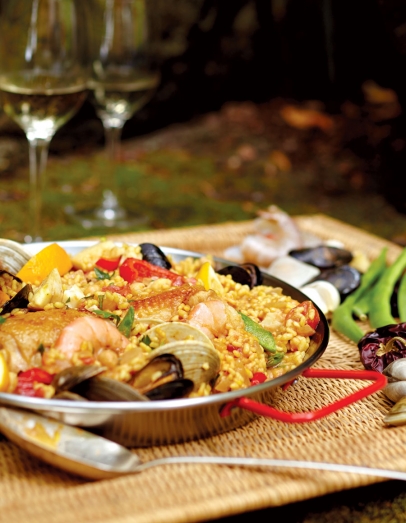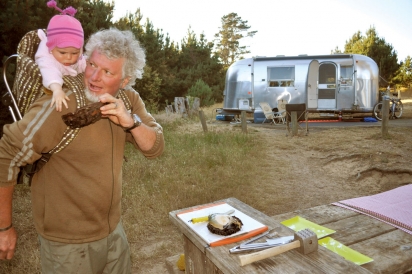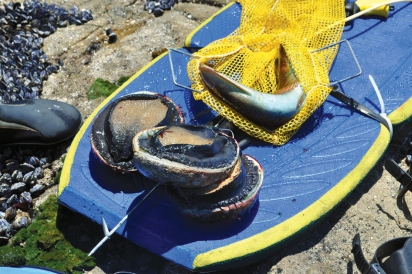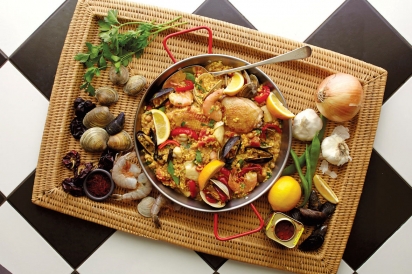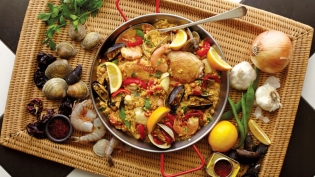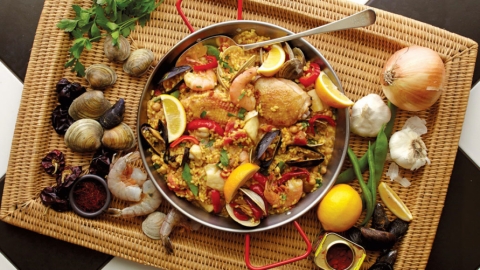Gerard Nebesky, America's Pied Piper of Paella
Gerard Nebesky, chef and former owner of the Bohemian Café in Occidental, has essentially cooked only one dish professionally for the last decade: paella, the beloved Spanish rice creation that varies from cook to cook but typically simmers a beguiling medley of seafood and chicken and vegetables.
Gerard, 48, cooks in pans as large as 10 feet across as many as 200 days a year at outdoor events and galas. He’s as much a regular at the Hardly Strictly Bluegrass festival in Golden Gate Park as singer Emmylou Harris. The last couple years he’s shipped his huge pans as far as Queens, New York, serving 1,800 at the World Maker Faire.
If there’s a Prince of Paella, it’s Gerard, who prevailed against star chef Bobby Flay in a televised paella throwdown in 2008.
Gerard endeared himself to me two years ago, tending two steaming paella pans in a vest pocket park in Calistoga. That night, he was cooking for 100 or so wedding rehearsal dinner guests that my wife and I were hosting as parents of the groom. Our son, Jeff, and daughter-in-law-to-be, Grace, who’d made sure we joined them in the long paella line at the previous year’s Hardly Strictly, had subsequently insisted they “had to have Gerard” cook their prenuptial dinner.
Which he did, with skill and aplomb and a warmth that rivaled the colorful, hearty dish he spooned onto everyone’s plate. Otherwise engaged that evening, I managed only a few pan-side minutes with Gerard during the cooking process after handing him a beer and raising my own to our good fortune in landing him for the evening.
A bear of a man with untamed curly hair and a goatee—both gone silver— Gerard chatted easily with all who wandered by his simple open-air kitchen, brightening the already-festive occasion with his radiant smile, and patiently demystifying the classic Spanish dish for all who inquired.
Owing to the blessed bustle of that evening I remember only one of the many cooking tips he surely shared: Fight every temptation to stir the paella. Otherwise, he cautioned, you’ll forfeit what the Spanish prize most, the socarrat, the toothsome crust that forms on the bottom of the pan.
But I did manage to file away a second nugget from that evening: the coastal paella cooking classes Gerard offers a couple times each year, announcing them in blast emails to his website subscribers. Morning of, he dons a wetsuit and dives for some of his in-the-pan and appetizer ingredients. If he’s lucky, he surfaces with his quota of abalone. Maybe spears a lingcod or a blue-fleshed cabezon. And perhaps scores some mussels off wave-washed rocks.
I’d be welcome, he said, to join him on the coast and audit one of his classes.
So here I am, not long after sunrise, riding beside Gerard in his Toyota Tundra pickup, license plate GPAELLA, heading north on Highway 1 with Bodega Bay and Jenner in the rearview mirror, beyond cell phone reception, on a blue sky September morning. We had driven this same stretch of road the day before, stopping at various pull-offs and parking areas so he could walk to the edge of a cliff to assess the turbidity and roughness of the waters in the coves below. Always: too murky, too dangerous to dive.
Today, with coastal winds diminished slightly, Gerard expects that he’ll be able to don his wetsuit—and hopes that the email his partner Anna is sending out will lure some seafood paella attendees to the ‘68 Airstream he’s parked at Sonoma County’s Doran Beach campground on the scenic spit of land separating Bodega Harbor from Bodega Bay.
Between curves on Highway 1, he points past me to the inland side of the road, to one of his favored terrestrial hunting grounds.
“There will soon be mushrooms like crazy in there,” he says. “The North Coast comes to life soon as the rains start and everything turns green. There are baby calves everywhere. It’s beautiful.”
He’s got spots for black trumpets, hedgehogs and boletes—prized porcinis. The last several years, returning to the base of a special coastal pine, he’s annually neared his daily five pound quota with a single specimen, a giant Boletus edulis—a king bolete, indeed.
In the woods, the big concern is poison oak. Gerard now keeps steroid cream and pills on hand to tame the itch and the swelling, which once so narrowed his vision that he had to pull over to the side of the road. On the other side of the highway, the Pacific holds many dangers: Rough surf; entanglement in kelp or seabed rock formations; and great white sharks. Most every year, at least a couple divers perish in pursuit of abalone along the California coast.
“A guy I go crabbing with in the winter has been hit twice,” he says. “Bit across the face and butt. Both times, great whites. A friend, he got killed. Had his head, neck and shoulders removed. He dove right into a shark’s mouth up the coast a little ways.”
Such is the appeal of abalone. Now copiously regulated by the California Department of Fish and Wildlife, it’s a rare, expensive delicacy in restaurants. Gerard has yet to taste any from the abalone farms that have sprung up in Monterey and other coastal locations. Nor have I, but a side-by-side comparison I did some years ago in Australia of wild caught versus farmed abalone echoed my take on free swimming versus penned salmon: Wild always wins on taste. There’s simply more flavor.
Shortly past 8am, after several cove inspections, Gerard is tugging on his wetsuit by the side of the road. Scuba gear is not allowed for abalone divers. He’s got a mask and snorkel; three-foot-long surf fins; a weight belt; gloves; boots; a short, blunt-ended steel pry bar with a yellow handle; a mesh bag for his catch; a boogie board—and the de rigueur state-issued tags and paperwork in a little waterproof packet.
He makes his way to the edge of the bluff and climbs down the rocks to where the low tide crashes. Waiting until just after a wave smashes ashore, Gerard bends and flops onto his outstretched boogie board and paddles out to the middle of the cove. He ties the board’s ankle strap to a surface-reaching arm of kelp. Then tucks his head, arches his back and dives like a seal.
He’s a capable free diver, preferring it to scuba diving, which he learned at age 12 while living in Australia with his father. He resided there through high school, returned to California for a couple years, then lived in New Zealand, where he helped his brother open restaurants.
“I was really into graphic design then and liked the whole artsy, stylish side of food,” he explains. “I was doing the interior design work and menu planning and then got into cooking while I was there.”
You don’t have to look long at one of his finished paellas to see his artistic side: black mussel shells, head-on shrimp, red pepper strips, lemon wedges artfully composed in the pan like a stained glass window.
“We take pride,” he says, “in decorating the heck out of it.”
Gerard surfaces. Dives again. After about a half dozen descents, he calls it quits. Freeing the boogie board, he paddles back to shore using the board as a shield to soften his landing. “It was getting rougher. I got two, but decided I didn’t want to try for a third,” he says. Three is the daily limit on abalone; annually, permit holders can bag 18.
The two black shells he pulls from his dive bag are just over the seven-inch size limit. No sooner has he tagged them than a Fish and Wildlife official appears to monitor his catch. When chatter about the weather and rising surf turns to Gerard’s plans to move on to gather mussels, there’s bad news. His intended cove has been quarantined from such foraging due to elevated levels of naturally occurring biotoxins. Mussels are such a paella staple that we stop at a Bodega Bay seafood market on the drive back south to his Airstream and buy some.
Back in cell phone range, Gerard learns from Anna that the email blast has attracted no spur of the moment weekday diners to today’s paella class, which he normally holds on weekends. Completely unfazed, he unloads his pickup and commandeers a picnic table near the Airstream for his gas burner and paella mise en place—including onions, peppers, garlic and a big tin of saffron. A dive-bombing seagull swipes the butter earmarked for sautéing abalone steaks. Pounded thin and simply browned in (plan B) olive oil and garlic, without the traditional breadcrumbs, the kelp-eating abalone tastes rich—more like veal, sweetbreads even—than overtly of the sea.
Gerard has plumbed his freezer for a jar of preserved-in-oil hedgehogs. A second jar contains black trumpet mushrooms. We spread the mushrooms on crackers and sip a Napa Tempranillo while the paella blossoms: chicken stock to cooked vegetables; medium-grained rice; then abalone; salmon he caught months ago and froze; the mussels; and lastly, lemon wedges. Enough for a small crowd. The dish smells wonderful and tastes just as good. It’s hearty and comforting and evocative of where we’ve been today and where we are at the moment.
“Paella is slow food,” says Gerard, lowering his wine glass. “Not only does the long cooking process really let all the flavors combine, it also really settles you into a nice evening. For me, the social aspect is the best part about it.”
Two bicyclists dismount in the adjacent campsite and waste little time setting up their tent, unknowingly within hailing distance of America’s Pied Piper of paella.
“I’m sure,” says Gerard, “those cyclists will want some.”
GERARD’S PAELLA PRIMER
Paella is one of those Holy Grail dishes that top chefs and home cooks aspire to make authentically, a seemingly complicated dish that’s prone to disaster. Relax. Here, Gerard shares five tips to help you have a smash in the pan.
- The “paella police” insist on cooking over a wood fire, but you can cook indoors on the stove,outdoors on a grill, even in the oven. What’s most important is that you use a shallow, flat-bottomed pan. This will allow the juices to steamaway without making the rice gloppy.
- You may substitute many ingredients (chicken for rabbit, green beans for peas, crab for lobster), but don’t stray from a medium- to short-grain rice. Spaniards are very loyal to Bomba, but for me the Calrose rice grown in California rivals Bomba both in flavor and texture and costs way less. Basmati, jasmine, or any long-grain rice will not work. All will burn instead of easing into a wonderful socarrat on the bottom of the pan. Brown rice will not work either, because it has to be covered to cook and that’s taboo in the world of paella.
- The most common cause of mediocre paella is filling the pan with too many ingredients and too much rice. Overly laden paellas will be mushy by the time the rice on top is cooked, and the flavor will be pale. My rule of thumb: Never go above the handle rivets on the inside of the pan.
- For many Spaniards and paella aficionados, the socarrat is as important as the saffron. This is the crusty blackened rice on the bottom of the pan—for many, the equivalent of turkey skin. It is achieved by not stirring the pan and waiting patiently until the liquid is gone, the rice is cooked on top, and the socarrat has formed on the bottom.
- People mistakenly associate paella with jambalaya or rice dishes from Mexico and think it needs to be spicy. Paella is not a spicy dish. It’s a Pinot Noir, not a big zesty Zinfandel. People asked us for hot sauce at big events until finally we put it out. You can slosh on the Scovilles, but resist the temptation—and you’ll better enjoy the subtle medley of flavors that paella has to offer.


